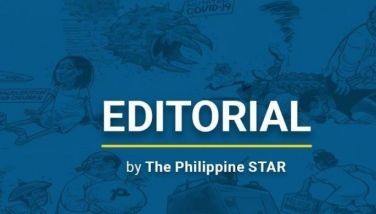Nuisance

This is the way a major political party ends in this country: Vetellano Acosta, standard-bearer of the once mighty Kilusang Bagong Lipunan (KBL) of the Marcos regime, was disqualified by the Commission on Elections (Comelec) yesterday for being a nuisance candidate.
For a while, Acosta provided comic relief in the campaign. But the Acosta jokes quickly wore thin and the Comelec finally decided to pull him out of the race.
Acosta, pleading lack of funds, never got his campaign off the ground. His disqualification was sought even by his running mate, broadcaster Jay Sonza. The Liberal Party complained that Acosta was in the race simply so he would be listed ahead of LP standard-bearer Noynoy Aquino on the ballot. Even some KBL stalwarts disowned Acosta.
Acosta’s group is said to be at odds with the most prominent KBL member, the only son and namesake of strongman Ferdinand Marcos, who is seeking a Senate seat. Like Sonza, Ferdinand “Bongbong” Marcos Jr. is supporting Sen. Manuel Villar, standard-bearer and president of the country’s oldest political party, the Nacionalista Party. Years before martial law, the elder Marcos had bolted the LP to run for president under the NP. He won and was later re-elected, promising to “make this country great again.”
The fate of the KBL is just one of the manifestations of what happened to that promise.
* * *
The party system in this country evolved from differences on raging issues — inspired no doubt by the system in the United States. The Nacionalista Party was launched in 1906 on a platform of a peaceful movement for independence from US colonial rule. On the other side were the Federalists, whose position is evident from the name.
After World War II, a group broke away from the NP and formed the LP. All the major political players in our post-war history belonged to one of these two parties. But even back then — as Marcos’ example showed — different positions on various issues were no longer providing a clear dividing line between the parties.
The KBL started out as a movement, ideally meant to serve as an umbrella organization for national unity after the LP and NP went into hibernation following the declaration of martial law in 1972.
It quickly became the ruling party. In this country, whoever sits in Malacañang rules. The ruling party is whichever organization is supporting the president and therefore enjoys the government’s resources and political machinery.
But at least during the dictatorship, the opposition party truly took positions that were markedly different from those of the ruling party. The opposition fielded Corazon Aquino in the snap elections in 1986 against the KBL’s seemingly invincible leader. We all know how that battle ended.
After Marcos fled into exile, the KBL started its rapid descent into irrelevance, occasionally punctuated by bizarre events such as the takeover of the Manila Hotel, long associated with the Marcos forces, by a loyalist group led by Marcos’ last vice president, Arturo Tolentino.
The opposition parties during the dictatorship naturally thrived during the presidency of Corazon Aquino. The KBL, on the other hand, failed to evolve into a credible opposition party, with many of its members simply defecting to the administration camp.
But for the 1992 presidential race, the ruling Laban ng Demokratikong Pilipino (LDP) picked a party stalwart, Ramon Mitra, over Cory Aquino’s preferred successor, her defense chief Fidel Ramos.
Ramos, possibly inspired by Marcos, bolted the LDP and formed his own party in December 1991. I will refer to the party simply as Lakas since the word has been the only consistent part of the party’s constantly changing formal names and affiliations.
The Aquino administration backed Ramos, who won by a plurality, and Lakas became the dominant party. Many LDP members jumped to Lakas, which to this day is affiliated with the Christian Democrats (now Christian and Muslim Democrats).
Unlike the KBL, Lakas did not disintegrate when its standard-bearer in 1998, Jose de Venecia Jr., was trounced by Joseph Estrada. Instead Lakas took on the role of minority party, which returned to power following Erap’s ouster. The opposition has since been fragmented.
Lakas fielded Gloria Macapagal-Arroyo as vice president in 1998, but her real party is the Kabalikat ng Malayang Pilipino. KAMPI leaders have long been at odds with their counterparts in Lakas, and the betting is that the two parties’ coalition will soon collapse. The poor showing of the administration candidate, Gilbert Teodoro, in the surveys is not helping party cohesiveness.
De Venecia, ousted from the party that he founded, is reportedly supporting Villar. Other Lakas members have jumped to either the NP or LP, or to Erap’s Pwersa ng Masang Pilipino.
Lakas is in its twilight, like the Arroyo presidency. A KAMPI stalwart, meanwhile, has reportedly been bragging that whoever wins in May, he is assured of a good position in government.
* * *
There are certain differences in the approaches of the presidential aspirants to the nation’s problems. Noynoy Aquino wants to focus on the battle against corruption to ease poverty; Villar wants to focus on the battle against poverty to ease corruption. Erap thinks the absence of peace and order is the root of our problems. Teodoro promises competent governance.
But those are the candidates. Are their views perceived as party platforms? There are in fact major or nuanced differences emerging on their stands on various issues, including family planning. If they can hang on to those views long enough, people might soon identify political parties with a particular position.
In the meantime, a political party is still defined by its most prominent member. And people join parties, or flit from one to another, with only one concern: What’s in it for me?
The KBL has no answer to that question that might entice recruits who are better than Vetellano Acosta.
- Latest
- Trending





















